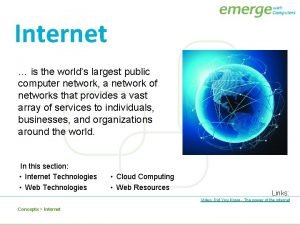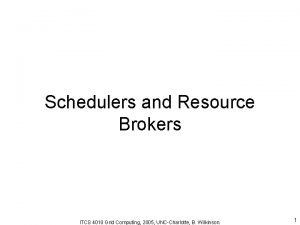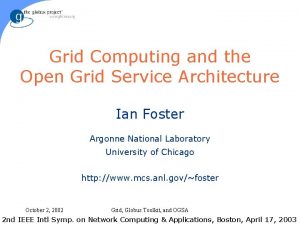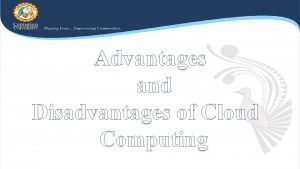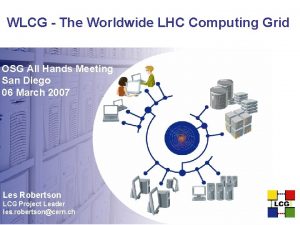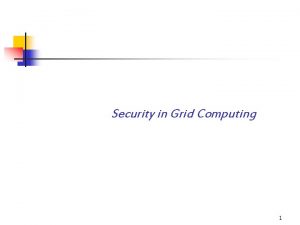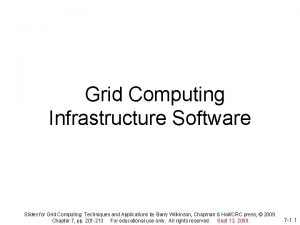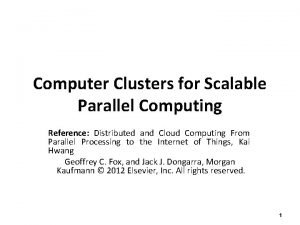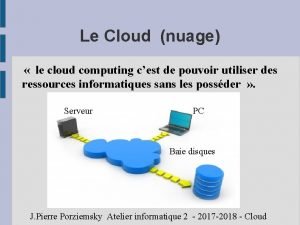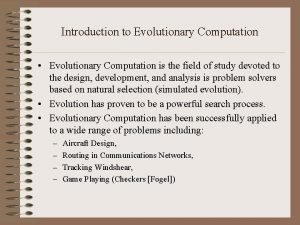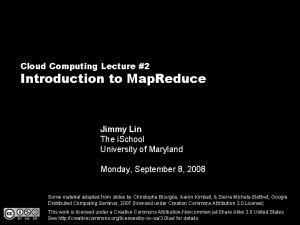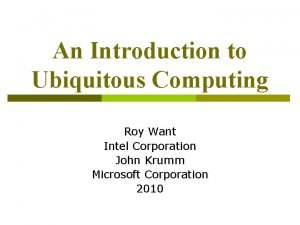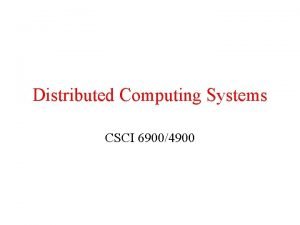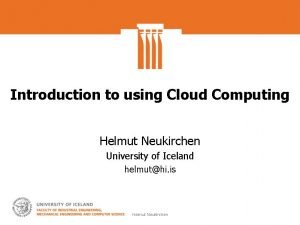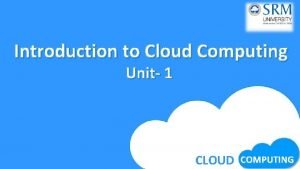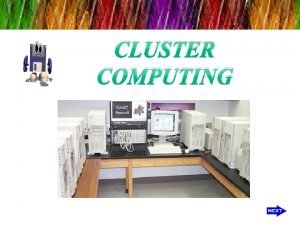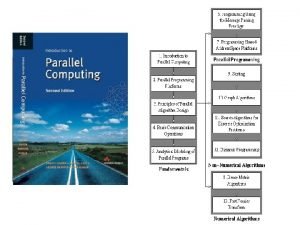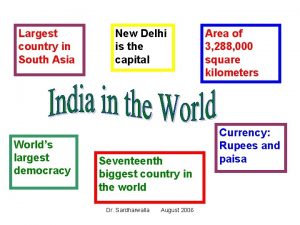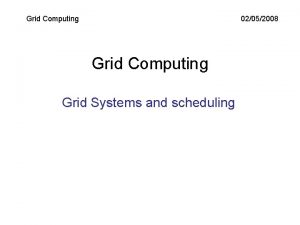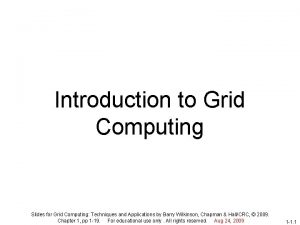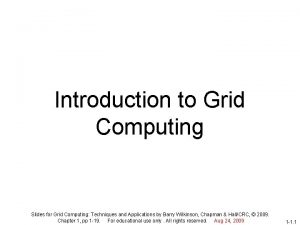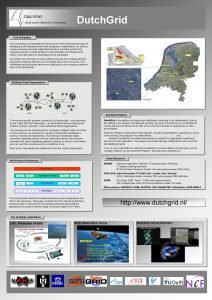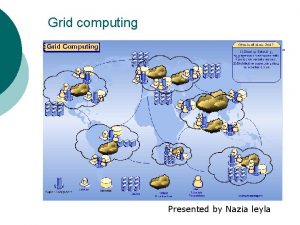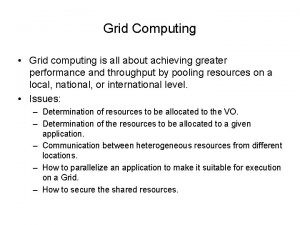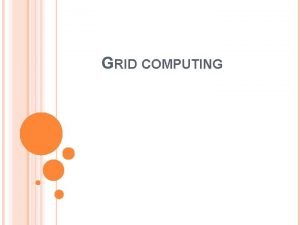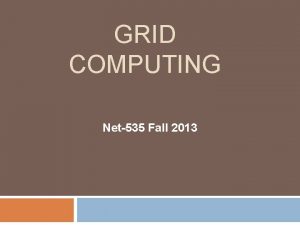GRID COMPUTING Worlds largest virtual computer INTRODUCTION Grid























































- Slides: 55

GRID COMPUTING World’s largest virtual computer

INTRODUCTION Grid computing is a term referring to the combination of computer resources from multiple administrative domains to reach common goal.

INTRODUTION

Definition A large-scale geographically distributed hardware and software infra-structure composed of heterogenous networked resources owned and shared by multiple administrative organizations which are coordinated to provide transparent, dependable, pervasive and consistent computing support to a wide range of applications. These applications can perform either distributed computing support to wide range of applications. These applications can perform either distributed computing, high throughput computing, on-demand computing, data intensive computing, collaborative computing or multimedia computing.

TYPES OF GRID COMPUTING Computational Grid Data Grid

Computational Grid Why do we need ? Computational approaches to problem solving have proven their worth in almost every field of human endeavour. Computers are used for modelling and simulating complex scientific and engineering problems, diagnosing medical conditions, controlling industrial equipment, forecasting the weather…………

Computational Grid Example of Traffic Computational Grid Application

Computational Grid There are variety of reasons for lack of use of computational problem-solving methods, including lack of proper education and tools. But one important factor is that the average computing environment remains inadequate for sophisticated computational tasks.

Computational Grid The computational grid environments that provides a demand-driven, reliable, powerful, and yet inexpensive computational power for its customers.

Data Grid In Increasing number of scientific disciplines large data collections are emerging as important community resources. For example The weather forecasting data which already in terrabytes should work with Global Information System at different locations then working with this large volume of data requires data to be distributed and accessed by several users

Data Grid This kind of large data set usage geographic distribution of users and resources and computationally intensive analysis results in complex stringent performance demands that are not satisfied by an existing data management system. This led to introduce a Data Grid.

Grid Applications Application partitioning that involves breaking the problem into discrete pieces Discovery and scheduling of tasks and workflow Data Communications distributing the problem data where and when it is required

Grid Applications Provisioning and distributing application codes to specific system nodes Result management assisting in the decision processes of the environment Autonoimc features such as self-configuration, selfoptimization, self-recovery and self-management.

Grid Benefits No need to buy large six figure SMP servers for applications that can be split up and farmed out to smaller commodity type servers. Results can then be concatenated analyzed upon job(s) completion.

Grid Benefits Jobs can be executed in parallel speeding performance. Grid environments are extremely well suited to run jobs that can be split into smaller chunks and run concurrently on many nodes.

Grid Benefits Grid environments are much more modular and don't have single points of failure. If one of the servers/desktops within the grid fail there are plenty of other resources able to pick the load. Jobs can automatically restart if a failure occurs.

Grid Benefits Upgrading can be done on the fly without scheduling downtime. Since there are so many resources some can be taken offline while leaving enough for work to continue. This way upgrades can be cascaded as to not effect ongoing projects.

Grid Benefits This model scales very well. Need more compute resources? Just plug them in by installing grid client on additional desktops or servers. They can be removed just as easily on the fly. This modular environment really scales well.

Grid Benefits Policies can be managed by the grid software. The software is really the brains behind the grid. A client will reside on each server which send information back to the master telling it what type of availability or resources it has to complete incoming jobs.

Grid Benefits Much more efficient use of idle resources. Jobs can be farmed out to idle servers or even idle desktops. Many of these resources sit idle especially during off business hours. Policies can be in place that allow jobs to only go to servers that are lightly loaded or have the appropriate amount of memory/cpu characteristics for the particular application.

Drawbacks of Grid computing For memory hungry applications that can't take advantage of MPI you may be forced to run on a large SMP.

Drawbacks of Grid computing Some applications may need to be tweaked to take full advantage of the new model. Licensing across many servers may make it prohibitive for some apps. Vendors are starting to be more flexible with environment like this.

Drawbacks of Grid computing Political challenges associated with sharing resources (especially across different admin domains). Many groups are reluctant with sharing resources even if it benefits everyone involved. The benefits for all groups need to be clearly articulated and policies developed that keeps everyone happy. (easier said than done. . . )

Drawbacks of Grid computing Grid environments include many smaller servers across various administrative domains. Good tools for managing change and keeping configurations in sync with each other can be challenging in large environments. Tools exist to manage such challenges include systemimager, , Opsware, Bladelogic, pdsh, cssh, among others.

Drawbacks of Grid computing You may need to have a fast interconnect between compute resources (gigabit ethernet at a minimum). Infiband for MPI intense applications

Grid Components Grid Portal Security Broker Scheduler Data Management Job and Resource Management Resources

Grid Portal

Security

Broker

Scheduler

Scheduler

Data Management

Job Management

Grid Architecture

Fabric Layer The Fabric Layer defines the resources that can be shared. Example: computational resources, data storage, networks, catalogs and other system resources. These resources can be physical or logical

Fabric Layer Example of Logical resources: file systems , software applications. These logical resources are implemented by their own internal protocol(eg. NFS for distributed file system) These resources then comprise their own network of physical resources.

Fabric Layer There are no specific requirements for a particular physical resources that relates to integrate itself as part of any grid system. It recommends to have basic capabilities associated with the integration of resources. Provide an “inquiry” mechanism which allows to discover against its own resource capabilities. Provide appropriate “resource management” capabilities to control the Qo. S the grid solution promises.

Connectivity Layer It manages connections. It defines the core communication protocols and authentication protocols required for grid-specific networking services transactions. The communication protocols can work with any of the networking layer protocols that provide the transport, routing and naming capabilities in networking services solutions.

Connectivity Layer The Authentication protocol builds on top of the networking communication services in order to provide secure authentication and data exchange between users and respective resources.

Resource Layer The Resource Layer utilizes the communication and security protocols defined by the networking communications layer, to control the Secure negotiation Initiation Monitoring Metering Accounting Payment involving sharing of operations

Resource Layer Information Protocols: These protocols are used to get information about the structure and the operational state of a single resource Including Configuration Usage Policies Service-Level agreements State of the resource

Resource Layer Management Protocols: These provide the following functionalities Negotiating access to a shared resource is paramount. Performing operations on resource such as process creation or data access Acting as the service/resource policy enforcement point for policy validation between a user and resource. Providing accounting and payment management functions Monitoring the status of an operation, controlling & termination

Collective Layer Resource Layer Manages individual resource while the collective layer is responsible for all global resource management and interaction with a collection of resources. Examples Discovery Services Coallocation, Scheduling and Brokering Services Monitoring and Diagnostic Services

Application Layer These are user application, which are constructed by utilizing the services defined at each lower layer. Such an application can directly access the resource or can access the resource through the Collective Service Interface APIs

Grid relation to Distributed Technologies World wide web Distributed Computing Systems Application and storage service providers Peer-to-peer computing systems

World Wide Web A number of open and ubiquitous technologies are defined for the WWW that makes the web a suitable candidate for the construction of the virtual organizations. However web is defined as a browser-server message exchange model, and lacks the more complex interaction models required for a realistic virtual organization

World Wide Web Examples: Single-sign-on Delegation of Authority Complex Authentication Mechanisms Once browser to server interaction matures, the web will be suitable for the construction of grid portals to support multiple virtual organizations.

Distributed Computing Systems Major distributed technologies including CORBA, J 2 EE and DCOM are well suited for distributed applications. However these do not provide a suitable platform for sharing of resources among the members of virtual organization.

Distributed Computing Systems Another major drawback in distributed computing systems involves the lack of interoperability among the protocols. Some of the distributed technologies have attracted Grid computing research attention towards the construction of grid systems, most notable of which is Java JINI.

Application and storage Service Providers Application and storage service providers normally outsource their business and scientific applications and services, as well as very high-speed storage solutions, to customers outside their organizations. Customers negotiate with these highly effective service providers on Qo. S requirements.

Application and storage Service Providers These type of advanced services arrangements are executed over some type of virtual private network or dedicated line by narrowing the domain of security and event interactions. This in turn reduces the visibility of the service provider to a lower and fixed scale with the lack of complex resource sharing among heterogenous systems and interdomain networking service interactions.

Application and storage Service Providers This being said, the introduction of the Grid Computing principles related to resource sharing across virtual organizations along with the construction of virtual organizations yielding interdomain participation.

Peer-to-Peer Computing Systems Similar to Grid Computing, peer-to-peer computing is a relatively new computing discipline in the realm of distributed computing. P 2 P and distributed computing are focussed on resource sharing and are now widely utilized throughout the world by home and commerical markets.

Peer-to-Peer Computing Systems The major differences are: 1. They differ in their target communities. Grid communities can be small with regard to number of users, yet will yield a greater applications focus with a higher level of security requirements and application integrity. On the other hand p 2 p systems define collaboration among a larger number of individuals and or organizations, with a limited set of security requirements and a less complex resource sharing topology.

Peer-to-Peer Computing Systems The grid systems deal with more complex, more powerful, more diverse and a highly interconnected set of resources than that of the P 2 P.
 The internet is the worlds largest
The internet is the worlds largest Norton worlds together worlds apart
Norton worlds together worlds apart Worlds largest dam
Worlds largest dam Travel and tourism is the world's largest industry
Travel and tourism is the world's largest industry Biggest internal combustion engine
Biggest internal combustion engine Grid computing introduction
Grid computing introduction Grid computing introduction
Grid computing introduction Introduction to grid computing
Introduction to grid computing Virtual worlds
Virtual worlds Online virtual worlds for kids
Online virtual worlds for kids Conventional computing and intelligent computing
Conventional computing and intelligent computing Resource broker in grid computing
Resource broker in grid computing Open grid computing
Open grid computing Grid computing tutorial
Grid computing tutorial Grid computing disadvantages
Grid computing disadvantages Worldwide lhc computing grid
Worldwide lhc computing grid Sas grid computing
Sas grid computing Sas grid computing
Sas grid computing History of grid computing
History of grid computing Conclusion of grid computing
Conclusion of grid computing Derivatives of grid computing
Derivatives of grid computing Grid and cloud computing lmu
Grid and cloud computing lmu Grid computing ejemplos
Grid computing ejemplos Challenges of grid computing
Challenges of grid computing Grid computing security
Grid computing security Sas grid computing
Sas grid computing Cern grid computing
Cern grid computing Grid and cloud computing definition
Grid and cloud computing definition Grid computing infrastructure
Grid computing infrastructure Globus ftp
Globus ftp Has virtual functions and accessible non-virtual destructor
Has virtual functions and accessible non-virtual destructor Lga vs pga
Lga vs pga Computer clusters for scalable parallel computing
Computer clusters for scalable parallel computing Zonbu computer green computing
Zonbu computer green computing Pre mechanical era
Pre mechanical era Regarder introduction to cloud computing vidéos
Regarder introduction to cloud computing vidéos Introduction to parallel computing ananth grama ppt
Introduction to parallel computing ananth grama ppt Introduction to evolutionary computing
Introduction to evolutionary computing It 101 - introduction to computing
It 101 - introduction to computing Cs101 vu edu pk
Cs101 vu edu pk Introduction to mapreduce in cloud computing
Introduction to mapreduce in cloud computing Introduction to ubiquitous computing
Introduction to ubiquitous computing Introduction to mobile computing
Introduction to mobile computing It 101 introduction to computing
It 101 introduction to computing Distributed systems overview
Distributed systems overview Introduction to cloud computing
Introduction to cloud computing Introduction to cloud computing
Introduction to cloud computing It 111 introduction to computing
It 111 introduction to computing Cluster computing meaning
Cluster computing meaning If a software production gets behind schedule
If a software production gets behind schedule Introduction to parallel computing ananth grama ppt
Introduction to parallel computing ananth grama ppt Introduction to parallel computing ananth grama
Introduction to parallel computing ananth grama Virtual lab for computer organization and architecture
Virtual lab for computer organization and architecture Explain virtual memory in computer architecture
Explain virtual memory in computer architecture Studying a virtual ecosystem on a computer is an example of
Studying a virtual ecosystem on a computer is an example of A switched wan is normally implemented as a
A switched wan is normally implemented as a
